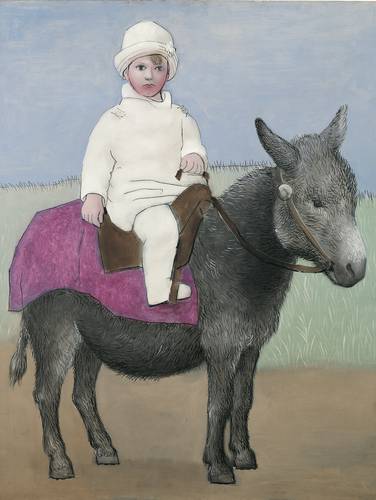Madrid. Pablo Ruiz Picasso was a renovator of art, promoter of the avant-garde and new languages throughout the 20th century, but sometimes his work has been seen in a segmented way, as if his cubist side were totally alien to classicism. or surrealism. Hence, the Picasso Museum of Malaga decided to renew its permanent collection and give it a new twist, both in terms of the works on display and the way of understanding the artistic legacy of the Malaga painter. It was decided to call the exhibition, which will last three years, Pablo Picasso: structures of invention. The unity of a work, and in some way closes the activities, exhibitions, debates and conferences that have been held over recent months around the 50th anniversary of the death (1973) of the Spanish artist.
After the exhaustive and prolific Picasso Year, which began at the end of 2022 and ended last April, the Malaga cultural venue approached his work as a whole from a new perspective, with the conviction that despite the great variety of the painter’s art, The themes of his pieces adhere to the traditional forms of Western art: the human figure, still life and landscape. The new permanent collection of the Picasso Museum in Malaga is made up of 144 pieces, 10 of them never before seen in Spain.
Range of styles
Hence, the Minotaur, bullfights, the family, eroticism and female figures are present in the new permanent exhibition at the Andalusian site, but they are mixed or dialogued through oil paintings, engravings, sculptures and ceramics, in a wide range of styles that ultimately reflect his life path. It is a way of remembering that Picasso renewed art by redefining traditions and inventing new forms of artistic expression.
The main theoretical person responsible for this new way of seeing Picasso was the Kluger family professor of art history at Trinity College in Hartford, Michael FitzGerald, who explained that Picasso’s creativity arose from two seemingly opposing inspirations: innovation and retrospection
and also that The interaction of these two concepts defines the creative paths that allowed him to integrate cubism, classicism, surrealism and his other innovations into the unit of work of a lifetime.
.
That idea was what inspired the exhibition, which seeks involve the viewer in the artist’s creative process and stimulate their imagination, creating a new cartography to understand the work of this great master and creator
stressed the art professor and curator of the exhibition, who above all seeks to move away from the conventional divisions of Picasso’s work – especially by stylistic and biographical periods – to propose the possibility of understanding his career as a unified artistic corpus.
Exhausted route
FitzGerald considered exhausted
that avenue of research with which Picasso is looked at in most studies, which is based on stylistic categories, such as the blue and rose periods; cubism, classicism and surrealism, to the point that his work seems to be reduced to isolated fragments that accumulate one on top of another. He, too, did not want to take on the recurring approach in the analysis of Picasso’s work, which takes the artist’s biography as a starting point and the compartmentalizations are made based on his relationships with women; hence we talk about the periods
by Fernande Olivier, Olga Jojlova, Marie-Thérèse Walter, Dora Maar, Françoise Gilot and Jacqueline Roque.
Hence, FitzGerald was convinced that in this curatorial proposal, “the unity of a work challenges this segmentation, reconnecting the stages of Picasso’s career. It is a miscellany of stages and also techniques – paintings, sculptures, ceramics, drawings and graphic works – so the new connections illustrate the way in which the artist’s astonishing creativity remained rooted in both his previous creations and his latest innovations. ”.
The 144 works on display also cover a long historical period, from 1895 to 1972, and the majority are pieces temporarily loaned by the Almine and Bernard Ruiz-Picasso Foundation (FABA), including three oil paintings, a sculpture, a ceramic, three drawings and two drawing notebooks that can be seen in Spain for the first time. In this group of works, the oil paintings stand out Paul (son of the artist) (1922) and woman head (1928), as well as the sculpture Layered woman (1933) y Spanish plat decorated with a bull’s head (1957).
The curator explained that “Paul is a portrait that Picasso made of his first son, whose representation in sketch form conveys both the informality of a child caught in that moment and the elegant beauty of the revival of Picasso’s classic styles, while woman head It confronts us with the extremes of emotion and the dark depths of the psyche that surrealism made the main theme of art and inspired much of Picasso’s work in the late 1920s and 1930s. Layered woman explores the possibilities that plaster offers as a support, and in the Spanish plat decorated with a bull’s headthe eyes, flattened snout, and wide mouth once again evoke the combination of human and beast of the Minotaur, and perhaps even Picasso himself.”
The exhibition can be seen at the Picasso Museum in Malaga over the next three years and closes the Picasso Year, for which a report was recently published detailing the 46 exhibitions in Spain and outside the country. , especially in France and the United States, which were seen by more than 6 million people. To carry out this succession of events and exhibitions, the cultural institutions of Spain and France were coordinated, in addition to several museums linked to the work of the artist from Malaga and public and private collections from both countries.
